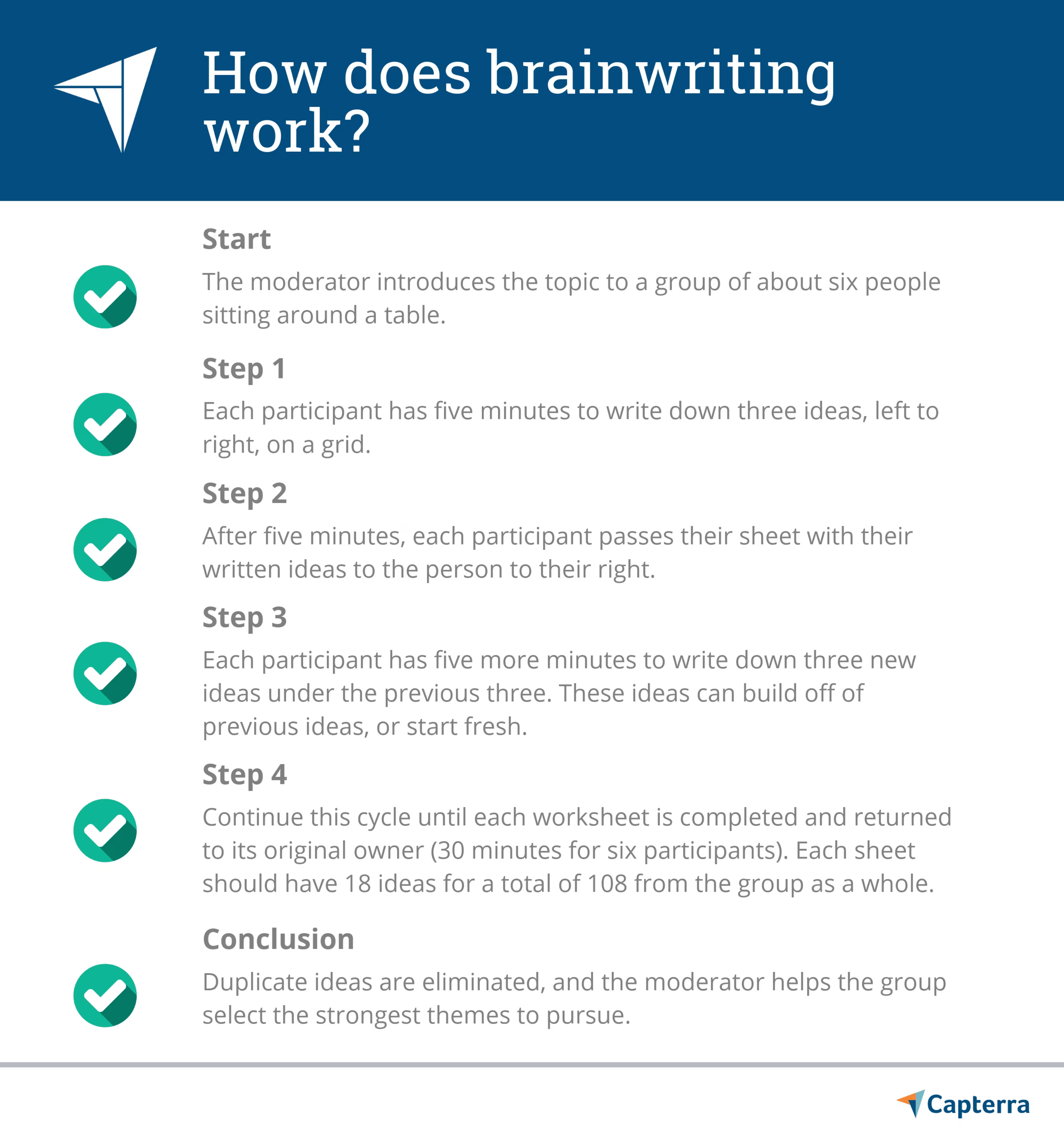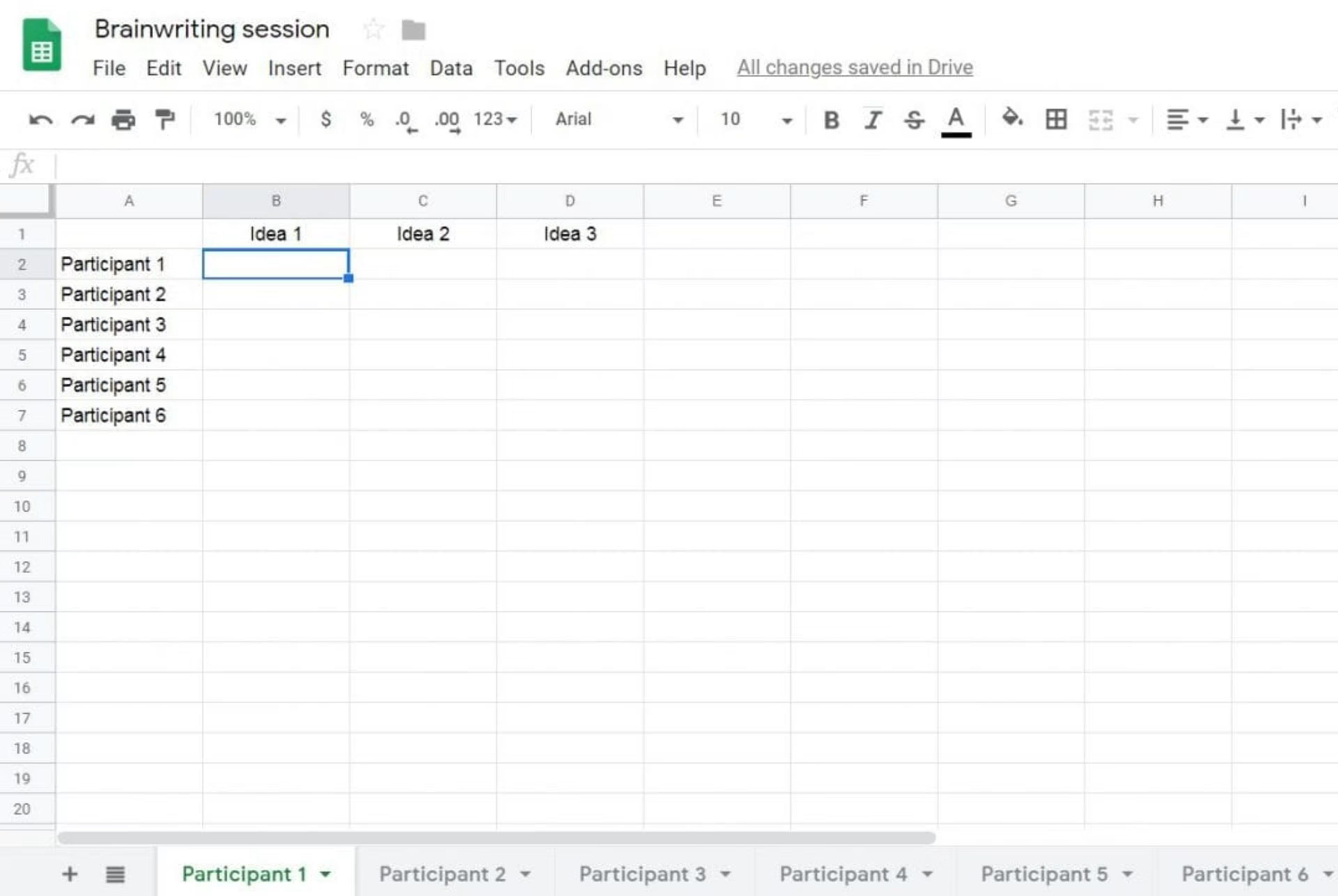Supercharge your ideation sessions to produce more than 100 ideas in just 30 minutes (free template included!)

Have you heard about the hot, new trend? All of the cool project managers are doing it with their teams. It's called brainwriting, and it's totally fab.
What's that, you say? You're already using brainstorms to generate new ideas, encourage collaboration, and tap into the collective knowledge of your team?
Oh, no, my friend. I'm not talking about brainstorming. I'm talking about brainwriting.
Why should you try brainwriting vs. brainstorming?
In their article "Drive a Creative Culture Through Activities, Education and Attitude," Gartner analysts Jackie Fenn and Mary Mesaglio suggest that using brainwriting instead of brainstorming "mitigates most of the differences in extraversion, communication style, and seniority that can lead to unbalanced contribution (full document available to Gartner clients)."
In this article, we'll look at the shortcomings of brainstorming for 21st century teams using modern project management technology and how brainwriting can help close the gap.
I've also included a free brainwriting template that you can use both in person or with a remote team.
The difference between brainstorming and brainwriting
So, brainwriting versus brainstorming. How different could they be, you're wondering? I'm glad you asked.
We've all heard of brainstorming, and have been doing some form of it in various scenarios since elementary school. You sit in a room with some type of board to record things on, then you start throwing ideas at it.
Pretty simple, fairly effective. But brainstorming has its limitations.
Brainstorming is susceptible to domineering voices and hive mentality, and project teams need an approach that allows everyone to be heard and counted to ensure more innovative ideas and team buy-in.
Enter brainwriting, which was originally developed in the 1960s by German professor Bernd Rohrbach as the 6-3-5 method (six people with three ideas each per five-minute round).
So, how does brainwriting work? Fortunately, it's not much more complicated than brainstorming.

That's it! When was the last time you had a brainstorming session that produced 100+ ideas in about half an hour?
It's worth noting that brainwriting isn't just about increasing output. It also makes provisions for more introverted team members to contribute in a way that doesn't force them to alter their personality, and more unique, diverse ideas give your SMB a greater chance at innovation and success.
6 brainstorming challenges solved by brainwriting
Let's take a look at six scenarios where brainstorming can fall short, along with six brainwriting solutions for each.
At the end of this piece, we'll look at how technology can assist with brainwriting for remote teams (along with a free template!), and a quick list of questions to help you determine if brainwriting makes sense for your team.
1. Brainstorming is susceptible to domineering voices
The scenario: Your boss, Tony, holds weekly brainstorming sessions with fellow managers in his impressive corner office, but his opinions usually drown out the input of others, and most of the ideas that come out of the meetings are those that he came up with.
The brainwriting solution: In brainwriting, each individual can and must contribute to the ideation process. Everyone's ideas are weighed equally and the best ideas—not the loudest—have the most value. This happens because the ideas are contributed anonymously. Your neighbor knows who passed them the idea sheet, but when the 30 minutes is up, all of the ideas are weighed on their own merits by the group.
2. Brainstorming promotes hive mentality
The scenario: Alex comes up with three or four strong ideas to bring to each week's brainstorming session. But she almost always keeps them to herself and walks away from the sessions convinced that her ideas weren't that strong in the first place, because they were so different from the ideas that are usually brought up, and from what the team usually ends up doing.
The brainwriting solution: Everyone writes their ideas down to prevent any one person from putting their thumb on the scale. While participants are encouraged to build off of other ideas already recorded on the sheet when it's passed to them, they are also encouraged to add something completely new if inspiration strikes, whichever route feels more natural.
That is one of the inherent advantages of brainwriting: participants can expand off of each other's ideas until an idea has been exhausted. But unlike brainstorming, the idea changes because participants no longer have anything to add, not because someone else with a louder voice steered the conversation away from it.
3. Brainstorming can produce low-quality ideas
The scenario: It's Friday afternoon at 3 p.m. You had a team lunch to celebrate reaching sales goals last quarter. Now you and three others managers are sitting down to brainstorm ideas for next quarter's marketing campaign. Whose idea was it to schedule this meeting at 3 p.m. on a Friday anyway?
You need to come up with three quality ideas before calling it a week, so you scrounge together a few half-baked concepts before heading out to an early happy hour. But when Monday morning rolls around, you realize that you have to start the whole process over again because nothing you came up with was actually worthwhile.
The brainwriting solution: Because more than 100 ideas are generated during a brainwriting session, your team is able to work through the bad ideas and separate out the good ideas.
Much like writers having to "write through" writer's block, brainwriting allows teams to pump out the bad ideas so they can get to the good ones. With six people contributing 18 ideas each, and ideas building off of each other, there is little chance that nothing of quality will be produced.
4. Introverted contributors can be lost in a brainstorm
The scenario: You're pulling together a brainstorm session to discuss the implementation of a new project management system. You know that Ray is a certified PMP and has experience implementing project management software at a previous job, so you invite him to the brainstorming session.
But Ray is a bit of an introvert, and only responds to direct inquiries during the brainstorm with short answers. Afterward, he sends you a lengthy email outlining his thoughts, making you wonder if the brainstorm was a waste of everyone's time.
The brainwriting solution: Even introverted contributors can feel comfortable with brainwriting because everyone writes their ideas down. Someone like Ray who may experience discomfort in a traditional brainstorming structure has the same time and impact on the ideation process as anyone else in a brainwriting room.
Brainwriting also allows more eloquent participants to take less-confident participants' ideas and give voice to them.
5. Brainstorming allows apathy to thrive
The scenario: It's mid-November but you have an important Q1 planning meeting on the calendar. Half your team is more interested in their travel plans than ideating, though, and the brainstorm is more of a brainsprinkle, with multiple participants contributing nothing more than a nod here and there. You come away from the meeting with few new ideas.
The brainwriting solution: There's no hiding out in the back of the room with your head down in brainwriting. Everyone has to contribute. While ideas are contributed anonymously, there will be blanks on the sheet if someone completely checks out, allowing the moderator to regulate. Even if a participant is feeling uninspired and contributes little, their teammates can piggyback off of those ideas and turn them into something more substantial.
6. Brainstorming can quickly lose steam
The scenario: You have a brainstorming session set for 11 a.m. Within the first ten minutes there are a flurry of ideas, but as the caffeine wears off and your team starts to think about lunch instead of planning, you lose momentum. Before the halfway point of your hour-long meeting, all you can hear are crickets and grumbling stomachs instead of ideas.
The brainwriting solution: Like interval training, brainwriting builds in recovery time between spurts of activity to allow for fresh ideas and renewed energy.
You have to focus for five minutes to come up with three new ideas, but then you get a brief break to pass the paper, and your neighbor's ideas will change your focus and help you think of new ways to tackle the challenge at hand. The segmented, 30-minute brainwriting session also gives all participants a heads up on exactly how long they need to mentally budget and focus for.
How technology can help with remote brainwriting
Do you have a remote team but still want to try brainwriting? No problem. Collaboration tools can help.
Just set up a video conference and shared spreadsheet (using a platform like Google Sheets) with your group. The moderator presents the topic or challenge as they would in person, then each participant has five minutes to type out their ideas in an individual tab on the shared sheet (each participant will need their own computer, even if several are in the same location).

An example of a remote brainwriting session using Google Sheets (Click here to download this free template)
After five minutes, each participant virtually passes their ideas by clicking over to the tab on their right. They then have five minutes to add to the next participant's ideas, and the process continues until all tabs have been filled. After the brainwriting session, the moderator collects all the ideas, removes duplicates, and breaks them down with the team over the video call.
Is brainwriting right for your team?
To be fair, there are still times when brainstorming is a perfectly good approach. Namely: situations where domineering voices and lack of output are not a concern.
Brainstorming also works better when you only have a few people. If you have three or four managers on equal standing eager to tackle a problem, for example, a traditional brainstorming session could work perfectly well.
Now that we've looked at some specific situations where brainwriting can help, though, it's time to ask yourself if brainwriting is a good, or better, idea for your team.
Do you have members of your team who can seem reluctant to chime in during traditional group brainstorming sessions?
Does your team struggle to produce enough new ideas during traditional group brainstorming sessions?
Does your team have around six people (give or take a few)? Or can you break your team up into groups of about six people?
If you answered yes to any of those questions, try brainwriting with your team, and see what happens. Worst case scenario, they don't like it and you go back to you've always done. Best case scenario, you've found a new team ideation technique that will improve your projects for years to come.
For more project management tips on everything from software to communication styles, be sure to follow our blog!